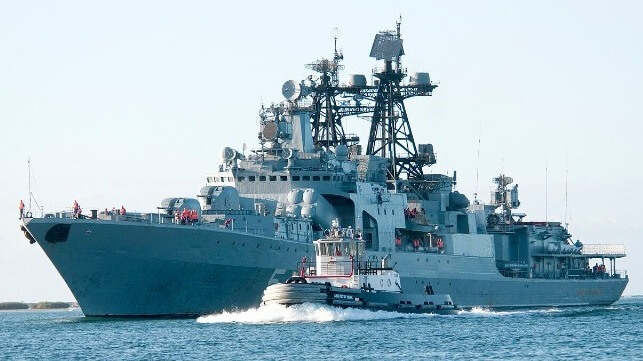After Losing a Flagship, Russian Navy Demonstrates Air-Defense Power

After the loss of the cruiser Moskva to Ukrainian anti-ship missiles last week, the Russian Navy has assigned a destroyer from its Pacific Fleet to demonstrate Russia's naval air-defense capabilities - particularly for use in the defense of Russian merchant shipping. The Udalay-class destroyer Admiral Panteleev was selected to lead the mock exercise.
"According to the plan of the exercise, the air defense crews of the ship covered the medium sea tanker Izhora . . . from a mock enemy missile. The personnel of the ship discovered an air target flying towards a sea tanker . . . and, when an 'enemy' missile entered the affected area, destroyed an air object with an anti-aircraft missile system," said Russia's Eastern Military District in a statement. "The actual firing of the anti-aircraft missile system was not carried out."
Analysts contacted by South China Morning Post suggested that the exercise was intended to convey Russia's willingness to defend its shipping from interference - particularly its tanker fleet. As NATO allies increase pressure on Russia over the invasion of Ukraine, Russian tankers are attracting unwelcome attention, including protests and (in at least one instance) the possibility of sanctions-related seizures.
The day after the exercise announcement, Japanese forces spotted the Panteleev in Tsushima Strait, the waterway between Tsushima Island and Kyushu. She was accompanying the pipelay ship Akademik Cherskiy, the OSVs Ivan Sidorenko and Ostap Sheremeta, the rescue tug SB-406 and the fleet oiler Izhora.
"It is rare for Russian [merchant] vessels to sail together with warships," a ministry official told Kyodo News.
One vessel in the convoy stands out: the Akademik Cherskiy, which is nearing the end of a long voyage home. She carried out some of the final pipelay work on the now-abandoned Nord Stream 2 project in 2021, defying American sanctions in order to install a subsea bypass pipeline through the Baltic. Her work complete, she got under way from Rotterdam on her homeward journey on January 28. Since then, she has made slow but steady progress around the Cape of Good Hope, through the Strait of Malacca and north through Tsushima Strait.
